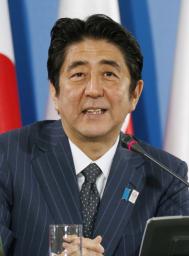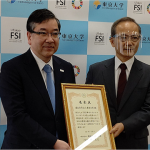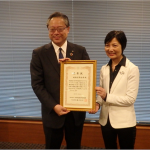|HOME
|Gov't lacks sense of responsibility over Fukushima radioactive water leak (Mainichi) |
Gov't lacks sense of responsibility over Fukushima radioactive water leak (Mainichi)
2013-08-25 14:58:44

 Revelations that about 300 tons of water contaminated with radioactive substances has leaked from an above-ground tank at the tsunami-hit Fukushima No. 1 Nuclear Power Plant have demonstrated that the nuclear crisis has not yet been brought under control.
It was the largest amount of radioactive water that has leaked from a tank on the premises of the power station, and the Nuclear Regulation Authority (NRA) is considering rating the accident as Level 3, or a serious incident, on the International Nuclear and Radiological Event Scale.
Prime Minister Shinzo Abe said the government will take countermeasures against the leakage of contaminated water. Actually, however, the government has failed to play a key role in efforts to bring the crisis under control while basically leaving the daily response to the crisis to plant operator Tokyo Electric Power Co. (TEPCO). The government should have a sense of responsibility and play a more active role in responding to the crisis.
Radioactive water has leaked from a cylindrical tank with a capacity of 1,000 tons, which was assembled by joining steel plates with bolts. The tank contained water used to cool down nuclear reactors, from which radioactive cesium was removed.
Of some 1,000 tanks at the crippled plant containing radioactive water, about 350 were built by joining steel plates with bolts and the rest of them were built by welding steel plates.
It’s quicker to assemble tanks by joining steel plates with bolts, but water can leak from joint areas more easily than welded tanks. Water leakage from such tanks had previously occurred four times. In the latest case, it remains to be seen from which part radioactive water leaked, and the possibility cannot be ruled out that further water leakages will occur.
Following the latest revelations, TEPCO began to examine tanks with bolts and is set to increase the frequency of daily inspections on such tanks from two to three times a day. The utility needs to clarify the cause of the leakage and the reason why it was slow to detect the problem, and fundamentally review the way it inspects and maintains the tanks. It must also confirm if radioactive water has leaked from the tank into the sea and whether the tainted water contaminated underground water in the area.
TEPCO is supposed to treat radioactive water in multi-nuclide removal equipment after radioactive cesium is removed from it. However, the equipment remains stalled after it developed trouble during its trial operations. To reduce the risk the contaminated water poses to the environment, TEPCO should quickly repair and reactivate the equipment.
TEPCO is considering what it calls an underground water bypass system as an emergency countermeasure against the influx of underground water onto the premises of the power station, which is the primary cause of an increase in the amount of contaminated water. In the system, a well will be drilled into the plant’s mountainside area to allow underground water to be pumped up before being contaminated with radioactive substances and discharged into the sea. However, the plan still cannot win consent from the local communities hosting the power station for fear that it could fuel harmful rumors about local agricultural and fisheries products.
It came to light in April this year that tainted water was leaking from an underground water tank at the plant. It then surfaced last month that underground water on the premises of the power station got mixed with highly contaminated water and was leaking into the ocean. As the leakage of radioactive water is drawing worldwide attention, it could adversely affect the international community’s confidence in Japan.
The NRA has set up a panel to study the impact that radioactive water on the premises of the crippled nuclear plant has on the sea. The panel should objectively analyze relevant data that can provide a basis for judging whether the water is posing a threat to the environment, and actively dispatch such information to the world.
If TEPCO goes ahead with the creation of the underground water bypass system, the national government must do its best to convince local communities as well as the general public of the entire plan, including a response to possible contamination that could occur as a result of the system’s operation.
http://mainichi.jp/english/english/perspectives/news/20130822p2a00m0na008000c.html
Revelations that about 300 tons of water contaminated with radioactive substances has leaked from an above-ground tank at the tsunami-hit Fukushima No. 1 Nuclear Power Plant have demonstrated that the nuclear crisis has not yet been brought under control.
It was the largest amount of radioactive water that has leaked from a tank on the premises of the power station, and the Nuclear Regulation Authority (NRA) is considering rating the accident as Level 3, or a serious incident, on the International Nuclear and Radiological Event Scale.
Prime Minister Shinzo Abe said the government will take countermeasures against the leakage of contaminated water. Actually, however, the government has failed to play a key role in efforts to bring the crisis under control while basically leaving the daily response to the crisis to plant operator Tokyo Electric Power Co. (TEPCO). The government should have a sense of responsibility and play a more active role in responding to the crisis.
Radioactive water has leaked from a cylindrical tank with a capacity of 1,000 tons, which was assembled by joining steel plates with bolts. The tank contained water used to cool down nuclear reactors, from which radioactive cesium was removed.
Of some 1,000 tanks at the crippled plant containing radioactive water, about 350 were built by joining steel plates with bolts and the rest of them were built by welding steel plates.
It’s quicker to assemble tanks by joining steel plates with bolts, but water can leak from joint areas more easily than welded tanks. Water leakage from such tanks had previously occurred four times. In the latest case, it remains to be seen from which part radioactive water leaked, and the possibility cannot be ruled out that further water leakages will occur.
Following the latest revelations, TEPCO began to examine tanks with bolts and is set to increase the frequency of daily inspections on such tanks from two to three times a day. The utility needs to clarify the cause of the leakage and the reason why it was slow to detect the problem, and fundamentally review the way it inspects and maintains the tanks. It must also confirm if radioactive water has leaked from the tank into the sea and whether the tainted water contaminated underground water in the area.
TEPCO is supposed to treat radioactive water in multi-nuclide removal equipment after radioactive cesium is removed from it. However, the equipment remains stalled after it developed trouble during its trial operations. To reduce the risk the contaminated water poses to the environment, TEPCO should quickly repair and reactivate the equipment.
TEPCO is considering what it calls an underground water bypass system as an emergency countermeasure against the influx of underground water onto the premises of the power station, which is the primary cause of an increase in the amount of contaminated water. In the system, a well will be drilled into the plant’s mountainside area to allow underground water to be pumped up before being contaminated with radioactive substances and discharged into the sea. However, the plan still cannot win consent from the local communities hosting the power station for fear that it could fuel harmful rumors about local agricultural and fisheries products.
It came to light in April this year that tainted water was leaking from an underground water tank at the plant. It then surfaced last month that underground water on the premises of the power station got mixed with highly contaminated water and was leaking into the ocean. As the leakage of radioactive water is drawing worldwide attention, it could adversely affect the international community’s confidence in Japan.
The NRA has set up a panel to study the impact that radioactive water on the premises of the crippled nuclear plant has on the sea. The panel should objectively analyze relevant data that can provide a basis for judging whether the water is posing a threat to the environment, and actively dispatch such information to the world.
If TEPCO goes ahead with the creation of the underground water bypass system, the national government must do its best to convince local communities as well as the general public of the entire plan, including a response to possible contamination that could occur as a result of the system’s operation.
http://mainichi.jp/english/english/perspectives/news/20130822p2a00m0na008000c.html 
































 Research Institute for Environmental Finance
Research Institute for Environmental Finance